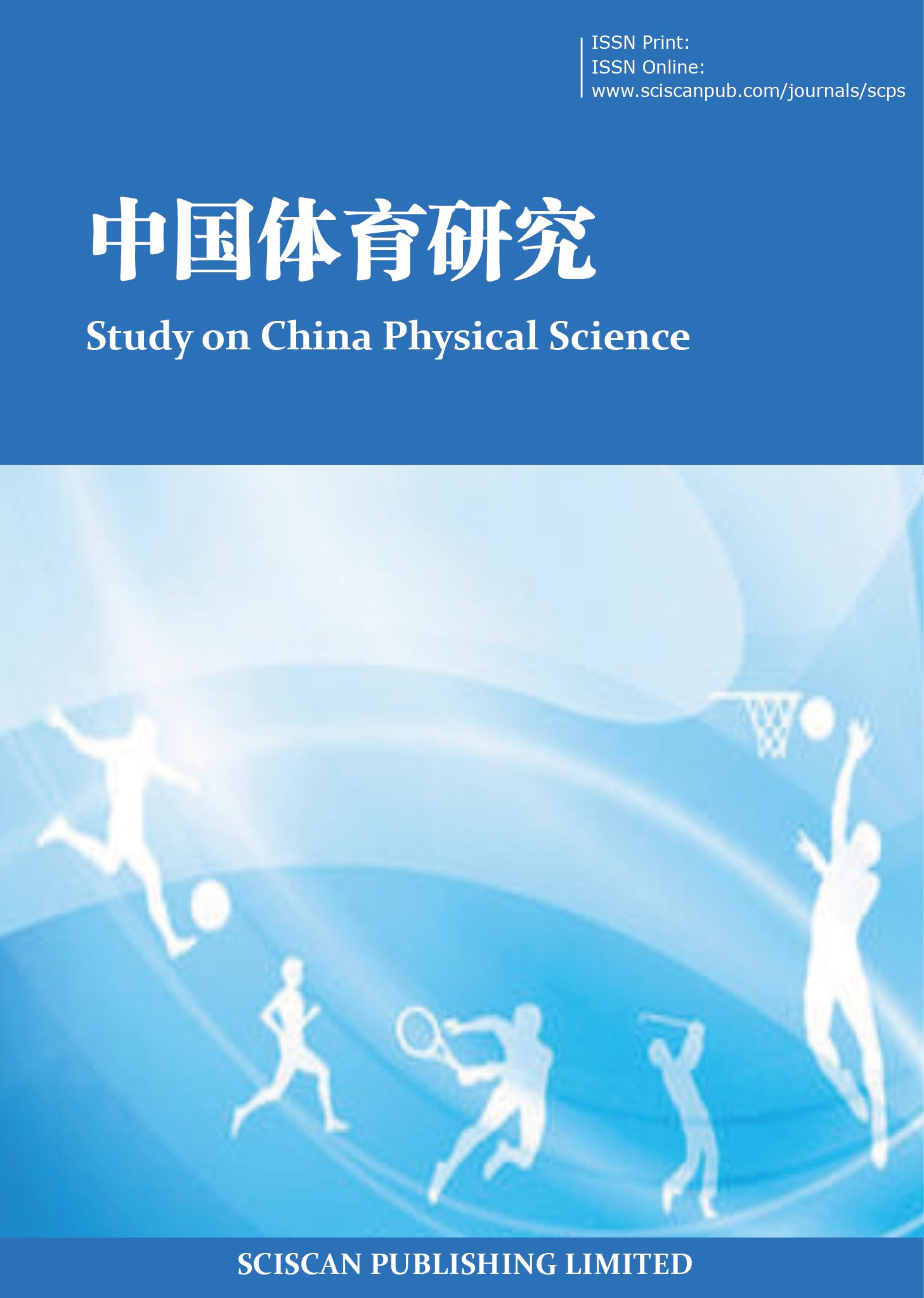Study on China Physical Science
太极拳改善久坐人群腰椎间盘突出的研究进展
Advances in Research on Tai Chi for Improving Lumbar Disc Herniation in Sedentary Populations
- Authors: 钟雪怡 李运
-
Information:
西南大学体育学院,重庆
-
Keywords:
Tai Chi; Sedentary populations; Lumbar disc herniation太极拳; 久坐人群; 腰椎间盘突出
- Abstract: Prolonged sitting often leads to lumbar muscle fatigue, increased intervertebral disc pressure, and decreased core strength, subsequently resulting in lumbar disc herniation. With the continuous rise in sedentary behavior in modern society, lower back pain has become increasingly prevalent, significantly impacting individuals’ quality of life. In recent years, research on Tai Chi has made notable progress in improving lumbar disc herniation among sedentary populations. As a Chinese traditional form of exercise, Tai Chi is widely utilized in health management and disease prevention due to its low risk and high efficacy. Existing literature demonstrates that Tai Chi can enhance muscle strength, improve spinal stability, and correct posture, effectively alleviating lumbar discomfort and pain while providing significant long-term protective effects. Compared to traditional physical therapy methods, Tai Chi is gentler and easier to maintain, making it particularly suitable for individuals with sedentary lifestyles. This study aims to provide theoretical foundations and practical support for the promotion of Tai Chi in the prevention and rehabilitation of lumbar disc herniation, offering effective intervention strategies for health management in sedentary populations. 久坐常导致腰部肌肉疲劳、椎间盘压力增加和核心力量下降,进而引发腰椎间盘突出。随着现代社会久坐时间的不断增加,腰痛问题日益普遍,严重影响了人们的生活质量。近年来,太极拳在改善久坐人群腰椎间盘突出方面的研究取得了积极进展。太极拳作为一种传统运动形式,因其低风险、高效益的特点,被广泛应用于健康管理和疾病预防领域。现有文献表明,太极拳可增强肌肉力量、提升脊柱稳定性和调整体态,有效缓解腰部不适和疼痛,并在长期防护方面产生显著效果。与传统物理治疗方法相比,太极拳更加温和且易于坚持,因此对久坐人群尤为适用。本研究旨在为太极拳在腰椎间盘突出的预防和康复中的推广提供理论依据和实践支持,为久坐人群的健康管理提供有效的干预手段。
- DOI: https://doi.org/10.35534/scps.0701009
- Cite: 钟雪怡,李运.太极拳改善久坐人群腰椎间盘突出的研究进展[J].中国体育研究,2025,7(1):62-67.
1 引言
随着现代社会信息化、智能化的不断发展,工作方式与生活方式发生了巨大的改变,久坐已经成了现代人的常见生活习惯。久坐人群通常指在日常生活中长时间处于坐姿、缺乏足够活动的人。2020年,世界卫生组织(WHO)在发布的《世界卫生组织关于体力活动和久坐行为的指南》中明确了久坐行为的定义:指在清醒状态下以坐姿、斜靠或平躺进行的能量消耗低于1.5 METs(代谢当量)的行为。包括工作和闲暇时间中的静态活动,如使用电子设备、阅读、交谈、驾车等。这一定义强调了久坐行为不仅限于办公室环境,还涵盖了日常生活中的多种低能量消耗活动[1]。长期久坐会对腰部肌肉造成显著损害,导致肌肉劳损和筋膜组织的破坏,容易引发腰椎间盘突出。研究表明,腰椎间盘突出具有发病率高、复发率高、患者生活质量低、经济负担重等特点。其总体发病率为2%~3%,在35岁以上人群中,女性的发病率约为2.5%,而男性则更高,达到约4.8%。这一疾病的广泛性和高复发性使其成为健康管理和治疗的重要研究领域[2]。
近年来,随着医学和运动学的不断进展,越来越多的研究表明,运动疗法对于改善腰椎疾病具有显著的疗效。不同类型的运动,如核心力量训练、伸展运动等,均被证明能够有效改善因久坐导致的腰椎间盘突出。与此同时,太极拳作为一种传统的中国武术,凭借其独特的运动方式和哲学理念,逐渐被应用于健康管理和疾病预防治疗中。对于长期从事久坐工作的人群,太极拳的温和性、低冲击性以及对身体各个部位的综合调节功能,使其成为一种非常适合改善腰椎间盘突出的运动形式。通过太极拳的练习,腰部肌肉群得到有效的放松和增强,脊柱的灵活性和稳定性得到提升,从而有效减轻久坐引起的腰部不适。
综上所述,太极拳作为一种低风险、无副作用的运动方式,为改善久坐人群腰椎间盘突出提供了有效的解决途径。本文将结合现有的研究成果,深入探讨太极拳在改善久坐人群腰椎间盘突出的效果与作用机制,为进一步推广太极拳在腰椎疾病防治中的应用提供理论支持。
2 久坐对腰椎的影响
久坐引发腰椎间盘突出的机制是多方面的,主要包括椎间盘压力的增加、姿势不良、肌肉失衡和核心力量不足、椎间盘退变、血液循环不畅等因素,这些因素进一步加速了腰椎的退化,导致腰椎间盘突出。
2.1 椎间盘压力的增加
长期久坐会通过改变脊柱的压力分布、降低椎间盘的自我修复能力,增加椎间盘的压力,从而引发腰痛、椎间盘退化或突出等问题。孙传睿等[3]认为椎间盘Ⅱ型胶原的减少和Ⅰ型胶原的增多,以及髓核和纤维环含水量的下降,导致椎间盘弹性逐渐降低,发生退变。在此基础上,如果遭受急性外力损伤或长期慢性劳损,会引发机械应力异常,导致椎间盘内压升高、纤维环破裂、髓核突出,最终导致腰椎间盘突出的发生。赵泽龙等[2]认为腰椎间盘突出症的发生通常与腰椎间盘的退行性变化有关,在外力或自身体重的影响下,椎间盘可能发生突出,进而压迫或刺激到脊髓或神经根,导致腰部疼痛、下肢放射性疼痛、麻木感,以及功能障碍等临床症状。范维[4]认为长期的外力负荷是促使腰椎间盘加速退化的关键因素之一。可见,久坐会使椎间盘的压力增加,造成腰椎间盘突出。
2.2 姿势不良
腰椎疾病是一种慢性疾病,其发展通常是一个长期的过程。长期保持不良的坐姿或行走姿势是导致该疾病的主要原因。从生理角度来看,脊椎在骨盆部呈现轻微的S形弯曲。当腰部承受过大的压力或长时间维持弯曲姿势时,腰椎可能发生形变,进而引发相关疾病。此外,长时间伏案工作或固定坐姿也容易导致腰部肌肉处于持续紧张状态,进一步加剧腰椎疾病的风险[3]。邓成龙[5]认为腰部作为躯干的核心部分,起着连接上下肢的至关重要的作用。长时间久坐会导致腰酸背痛及活动受限,这主要是由于不良坐姿和久坐状态下,腰部肌群和韧带受到过度拉伸。缺乏有效的腰部锻炼,使得腰肌力量逐渐减弱,从而引发肌肉力学上的不平衡。随着时间的推移,腰部肌肉的损伤会加重,进而导致活动范围的受限,并可能伴随不同程度的疼痛症状。大量研究都报道了久坐或不良坐姿是出现腰部疼痛、胸椎灵活性受限、颈椎压力过大、臀肌“失忆”和膝关节疼痛等问题的相关因素[4]。
2.3 肌肉失衡和核心力量不足
长期久坐导致肌肉失衡和核心力量不足,通过减少肌肉的使用和激活,导致部分肌肉群的萎缩与紧张。其他肌肉群的力量和稳定性逐渐下降,这种不平衡的肌肉状态会增加肌肉损伤、关节压力和疼痛的风险。萨德格-巴拉达兰-马赫达维(Sadegh Baradaran Mahdavi)等[6]认为长时间坐着和使用电脑与办公室工作人员的椎间盘供水量减少,从而导致退行性改变和椎间盘突出,力量和肌肉力量下降。刘书立等[7]认为腰椎间盘突出的根本原因在于附着于腰椎椎体、棘突、横突上的肌肉、肌腱和韧带等软组织的慢性挛缩和变性,或是腰背部与腹部肌肉力量的下降。这些因素导致腰椎的静态力量失衡,进而降低腰椎的稳定性,最终引发腰椎间盘突出。黄昀等[8]认为长期久坐会使肌肉进入错误的运动模式,增加肌力下降和肌肉不平衡的风险。腰腹肌群的短缩状态可能导致腰椎前凸和骨盆倾斜,进一步影响维持骨盆后倾和脊柱伸展功能的肌群(如臀肌、竖脊肌、多裂肌)。这些肌群因过度拮抗或代偿不足而出现异常的肌肉失衡。在身体长时间处于不良姿势或承受额外负荷时,背伸拮抗肌群容易受伤,从而引发腰痛问题。
2.4 椎间盘退变
长期久坐会导致椎间盘的退变和功能损伤。范维[4]认为腰椎间盘的退行性变化是腰椎突出的一大特征,髓核水分流失会导致椎体失衡,引起不稳定和松动,进而引发局部退行性病变。李刚等[9]认为腰椎间盘突出症多发于教师、计算机从业者、办公室职员、司机,以及中老年人群,腰椎退行性变化和外部创伤是该疾病发展的动态诱因。此外,纤维环的退化降低了椎体的韧性,进一步加剧了结构的改变。庞丹丹等[10]认为腰椎间盘由髓核、纤维环和软骨板等部分构成,当这些结构经历退行性变化后,髓核可能因外部因素影响,导致纤维环发生破裂。此时,髓核可能通过裂口突出或脱出,向后方或椎管内移位,突出的髓核会压迫或刺激邻近的脊神经根和脊髓,从而引起腰痛,且可能伴随单侧或双侧下肢的麻木和疼痛等症状。
2.5 血液循环不畅
久坐导致血液循环不畅,增加健康问题的风险。范维[4]认为随着年龄的增长,成人椎间盘的血液供应逐渐减少,这使得其修复能力显著下降。椎间盘髓核呈半透明的胶冻状,并随着机体功能的衰退或外部损伤,其原有的弹性逐渐丧失。腰椎间盘突出症通常因劳损引起经络阻滞、气血运行受阻,从而导致疼痛[11]。王力[12]认为长时间久坐会限制血液循环,导致臀部肌肉无法充分承受负荷,进而削弱身体对臀肌的利用能力。同时,髋关节因长时间弯曲可能部分丧失功能,引发不自觉的屈髋障碍,扰乱正常的运动模式。可见,久坐使得血液循环不畅,最终造成腰椎间盘突出。
综上所述,长期久坐引起椎间盘压力的增加、姿势不良、肌肉失衡和核心力量不足、椎间盘退变、血液循环不畅,最终造成腰椎间盘突出。
3 太极拳锻炼改善久坐人群腰椎间盘突出的效果
太极拳是一项缓慢、柔和,注重姿态与呼吸调节的练习方式。太极拳对腰椎间盘突出的改善具有多方面的积极效果,主要包括减轻疼痛、改善脊柱的柔韧性与稳定性、促进血液循环,从而能够预防久坐人群腰椎间盘突出的发生。
3.1 减轻疼痛
长期久坐会导致久坐人群腰椎间盘突出,而太极拳能够有效缓解这一疼痛。徐永峰等[13]认为太极拳作为一种传统疗法,广泛应用于腰痛的治疗。它对因身体虚弱或过度劳累导致的慢性腰痛同样有效,显著改善弯腰拾物的能力,还能有效缓解疼痛,促进腰部功能恢复。徐长明等[14]认为太极拳作为一种适合各年龄段人群的运动方式,已经被多项临床指南推荐为治疗非特异性腰痛的有效手段。卿光明[15]指出,太极拳运动对缓解腰椎间盘突出症患者的腰痛具有显著效果。通过舒展流畅的动作,有助于身体放松,并通过有节奏的肌肉活动促进气血的流通,从而有效减轻腰部疼痛。
3.2 改善脊柱的柔韧性与稳定性
通过太极拳锻炼,久坐人群可有效提升脊柱的柔韧性和稳定性,缓解久坐带来的负面影响。刘毅等[16]的研究表明,经过6个月的陈氏太极拳练习与体育康复训练结合,不仅显著矫正了颈椎前曲,还明显改善了腰椎前曲的状况。庞丹丹等[10]认为二十四式太极拳对腰椎间盘突出症患者的身体柔韧性及其他身体素质的提升具有显著效果。它不仅能够有效增强腰椎和骶椎的稳定性,还能帮助恢复腰椎的正常活动范围。宋桦等[17]认为太极拳强调“尾闾中正”,即保持尾闾(包括骶椎和尾椎)在中立位置,以确保身体姿势的平衡,从而实现安舒的状态。通过身法训练,脊柱的四个生理弯曲得到有效拉伸和调整,进而形成具有弹性的支撑中轴。脊柱整体通过拉伸、延展和松弛,不仅增强了其弹性,还使其平稳地安置于骨盆上方,体现了太极拳所追求的“立身中正”理念。此外,太极拳练习有助于放松腰部肌肉,减轻肌肉的紧张感,并增强肌肉的力量,这些改善对缓解腰椎间盘突出症的症状和体征至关重要。
3.3 促进血液循环
太极拳锻炼有效促进了久坐人群的血液循环,改善血液流动和局部血流,帮助缓解由久坐引起的血液循环不畅问题。研究表明,太极拳桩功对腰椎疾病患者的康复具有显著效果。通过长期进行桩功练习,不仅能够有效增强下肢肌肉的力量,促进全身血液循环,还能显著改善身体的功能状态,加速康复过程[3]。周勇等[11]认为太极拳注重外在动作与内在意念的协调,即“形动于外,神守于内”,通过意念来引导气血流动,实现身心的和谐统一。宋桦等[17]认为二十四式太极拳的动作有助于促进气血的流畅运行。此外,太极拳的练习还能有效预防组织缺氧,并及时排出体内的代谢废物,从而帮助维持身体的活力和健康。
综上所述,太极拳作为一种低风险、全身调理的运动,能够有效改善因久坐引发的腰椎间盘突出。通过练习太极拳,能够改善脊柱的灵活性,缓解肌肉紧张,促进血液循环,不仅有助于减轻腰部疼痛,还能改善身体姿势和整体功能。太极拳不仅适用于腰椎疾病的治疗,也在预防和长期康复中发挥着重要作用,尤其对于久坐人群来说,太极拳是一种理想的日常锻炼方式,有助于维持腰椎健康并预防疾病的进一步发展。
4 太极拳锻炼改善久坐人群腰椎间盘突出的机制
太极拳作为一种传统的中国运动形式,已被证明对久坐人群的腰椎健康有积极作用,其机制主要包括增强核心肌群力量、改善脊柱的灵活性和稳定性、促进血液循环和新陈代谢、调节神经系统等。
4.1 增强核心肌群力量
太极拳能够有效增强久坐人群的核心肌群力量,提高身体的稳定性、灵活性和耐力,从而改善由久坐引发的各种肌肉和关节问题。徐长明等[14]认为太极拳通过其静态、放松、缓慢、圆润及整体性的动作方式,能够有效锻炼脊柱周围的主要肌群,这对保持腰椎的生物力学平衡至关重要。其动作不仅有助于提高腰椎的动态稳定性,还从根本上增强了腰腹部核心肌群的力量,调节小关节,进而增强了腰椎骨骼结构的稳定性,对维持腰椎健康和预防相关疾病起到积极作用。孙会文[18]认为在站桩练习中,膈肌、腹部肌肉和骨盆底肌肉协同发力,提高了腹内压,有效减轻腰椎负担,并增强其稳定性。可见,长期进行太极拳锻炼可有效增强久坐人群的核心肌群力量,从而对腰椎健康产生积极的作用。
4.2 改善脊柱的灵活性与稳定性
太极拳通过改善脊柱的活动范围、减少肌肉紧张等方式,有效改善久坐人群的脊柱灵活性与稳定性。徐永峰等[13]认为陈式太极拳强调保持脊柱的正直,并通过腰部的灵活、柔和、螺旋式的动作来引领全身的运动,有效激活腰椎、颈椎及其周围关节、筋膜和韧带,增加身体感知的输入,从而提高神经肌肉控制力,减轻相关区域的疼痛感。孙会文[18]认为在桩功练习中,练习者保持头部微微上领,颈部直立,胸部内收,腰部微后塌,从而使下脊柱呈现出曲度减小、长度缩短和上下拉伸的综合状态,有助于调整脊柱曲线,强化腰部肌肉的锻炼。刘书立等[7]认为简化二十四式太极拳注重腰胯和脊柱的锻炼,能充分调动大肌群和小肌群协同发力,主要涉及腰方肌、腰大肌、多裂肌、竖脊肌、髂肋肌、腹直肌及腹外斜肌等,有助于延缓肌肉萎缩,增强弹性,提高控制力,从而全面提升身体功能。庞丹丹等[10]认为在太极拳练习中,“虚领顶劲”展现了脊柱向上的拉伸意图;而“气沉丹田”体现了脊柱向下拉伸的动能,两者相结合,能够有效拉伸整个脊柱,减轻椎体之间的压力,从而使身体处于一种舒适且平衡的状态。可见,长期进行太极拳锻炼,可有效改善久坐人群脊柱的灵活性与稳定性。
4.3 促进血液循环
长期进行太极拳锻炼,改善久坐人群的血液循环问题,提高机体的健康水平。Yeh GY等[19]认为,太极拳练习有效降低血清中B型利钠肽的水平,并增加心脏每搏输出量,从而显著促进全身的血液循环。曹奔等[20]认为太极拳通过动静结合、形神合一的练习,调节机体与外界的动态平衡,最终达到“天人合一”的境界。它强调“以气运身”,通过气息贯通经络,疏通腰部气血运行,推动血液循环,促进全身气血流动,特别是滋养冲脉并强化腰部功能。吴迎春等[21]认为太极拳的练习能够促进血液循环和静脉血液的回流,这有助于减少血液瘀滞,并改善器官和组织的能量供应,太极拳还能改善微循环,调节体液和神经系统,提高身体的活力。
4.4 调节神经系统
太极拳锻炼有效缓解久坐对神经系统的损害,并改善整体身心健康。赵文楠[22]认为太极拳的练习通过意念的调节,促使大脑中枢活动呈现出以高频α脑波为主导的节律性优势,有效增强个体的心理舒适感,是太极拳在缓解腰背部及肩颈部疼痛方面发挥效果的另一重要机制。滕国辉等[23]认为太极拳能够显著调整椎间盘与神经根的相对位置,减轻突出物对神经根的压迫。庞丹丹等[10]认为太极拳练习能够显著提升中枢神经系统中5-羟色胺的代谢水平,且该水平可达到普通人的两至三倍。此外,太极拳还能降低植物神经系统中交感神经介质去甲肾上腺素的代谢水平,幅度大约为20%至30%。这些变化表明,太极拳对中枢神经和植物神经功能的调节具有积极作用,有助于维持神经系统的整体平衡与健康状态。宋桦等[17]研究表明,太极拳通过增强腰骶椎的稳定性和减轻腰骶神经根的压迫,对外周神经传导功能的恢复具有积极的促进作用。
综上所述,太极拳通过多方面的作用,能够有效减轻久坐引起的腰椎间盘突出症状,并帮助恢复腰椎健康。它通过改善核心力量、增强脊柱的灵活性、缓解肌肉紧张、恢复正确的姿势、促进血液循环,以及提供心理放松,全面提升了腰椎的稳定性和功能。持续练习太极拳不仅有助于缓解已有的症状,还能有效预防腰椎疾病的发生,适合久坐人群作为日常的康复和预防运动,减轻久坐带来的腰椎负担,提升整体健康水平。
5 结论及展望
久坐对健康的影响十分显著,长期久坐会削弱肌肉力量,尤其是腰背和核心肌群,增加腰椎受损和腰痛的风险。太极拳作为一种传统的身心练习,对缓解久坐人群的腰椎间盘突出具有良好的效果,尤其是在缓解慢性疼痛、改善姿势、增强核心肌群、提高腰椎灵活性等方面效果显著。作为一种传统的健身方法,太极拳不仅关注身体的锻炼,还强调呼吸调节和身心合一,这对于久坐引起的肌肉僵硬、关节压力增加和腰椎健康有着明显的改善作用。
太极拳已被证明是改善久坐人群腰椎间盘突出的有效方法。然而,目前对其在久坐人群腰椎间盘突出上的机制研究仍存在不足。例如,现有研究多集中于临床观察,缺乏从细胞和分子水平揭示其作用机理的研究,同时临床样本量较小,缺少多中心、大样本的随机对照试验。此外,疗效评估通常依赖主观反馈,缺乏客观的指标观察,降低了研究的可信度。现有研究多关注治疗效果,预防性研究则较为匮乏,也缺少明确的运动处方和规范的锻炼形式。未来的研究应深入揭示太极拳在腰椎间盘突出中的生理机制,优化个性化训练方案,并开展更大规模的临床试验验证其普适性。结合核心肌群训练或物理治疗等其他方法,探索太极拳的综合治疗模式,可能有助于实现更显著的康复效果。与此同时,推广太极拳至社区和职场,或将有助于提升久坐人群的整体健康水平。
参考文献
[1]陈雅珊.社区公园老年人久坐行为特征及影响因素研究[J].家具与室内装饰,2024,31(7).
[2]赵泽龙,魏戌,银河,等.腰椎间盘突出症的中西医治疗述评[J].世界中医药,2023,18(21):3005-3012.
[3]孙传睿,冯天笑,王晓阳,等.运动疗法治疗腰椎间盘突出症的研究进展[J].世界中医药,2023,18(21):3031-3036.
[4]范维.太极拳运动对腰椎间盘突出症的康复效果研究[J].武术研究,2019,4(5):44-46.
[5]邓成龙.武医融合视域下八卦掌锻炼对久坐人群疼痛症状的影响研究[D].首都体育学院,2021.
[6]Mahdavi S B,Riahi R,Vahdatpour B,et al.Association between sedentary behavior and low back pain;A systematic review and meta-analysis[J].Health promotion perspectives,2021,11(4):393.
[7]刘书立,文太凤,韩芳,等.太极拳防治腰椎间盘突出症的临床疗效观察[J].山西中医学院学报,2018,19(3):36-37.
[8]黄昀,矫玮,朱晓东,等.久坐腰痛人群核心肌力状态特征及康复研究[J].西安体育学院学报,2020,37(2):218-224.
[9]李刚,王继超.陈氏太极拳的缠丝劲对治疗腰椎间盘突出症的意义[J].哈尔滨医科大学学报,2012,46(4):403-404.
[10]庞丹丹,王雪强,刘静.腰椎间盘突出症太极拳运动治疗研究进展[J].中国康复理论与实践,2010,16(11):1021-1023.
[11]周勇,孙雷,张珂.太极拳锻炼对亚急性腰椎间盘突出症的康复影响[J].福建体育科技,2012,31(2):25-26.
[12]王力.管窥体医融合的运动处方:八段锦与改善久坐“病”[J].武术研究,2024,9(7):4-7.
[13]徐永峰,张丽.太极拳练习对大学生肩颈腰背疼痛的改善效果评价[J].中国学校卫生,2019,40(7):994-996.
[14]徐长明,王雪强.太极拳对非特异性腰痛的影响和机制研究[J].中国康复医学杂志,2020,35(8):1009-1013.
[15]卿光明.太极拳运动治疗腰椎间盘突出症[J].现代预防医学,2012,39(16):4170-4172.
[16]刘毅,王春光.陈氏太极拳练习结合体育康复矫正脊柱弯曲40例疗效观察[J].中医药导报,2007(11):42-43.
[17]宋桦,高立.二十四式太极拳锻炼对腰椎间盘突出症影响的研究[J].北京体育大学学报,2008(5):627-629.
[18]孙会文.太极拳桩功对久坐人群腰椎疾病的预防和康复效果研究[J].辽宁体育科技,2016,38(4):46-49.
[19]Yeh G Y,Wood M J,Lorell B H,et al.Effects of tai chi mind-body movement therapy on functional status and exercise capacity in patients with chronic heart failure:a randomized controlled trial[J].Am J Med,2004,117(8):541-548.
[20]曹奔,郭光昕,朱清广,等.导引功法防治腰椎间盘突出症研究进展[J].世界中医药,2021,16(10):1633-1637.
[21]吴迎春,杨群,甘俊.太极拳联合辨证施护在腰椎间盘突出症护理中的应用效果[J].中医药导报,2018,24(5):123-126.
[22]赵文楠.太极拳锻炼对腰痛患者疗效的实证研究[J].武术研究,2016,1(4):59-62.
[23]滕国辉,陈景芳,柳宏野.太极拳对腰椎间盘突出症的预防和疗效分析[J].科技创新导报,2012(9):236.
















